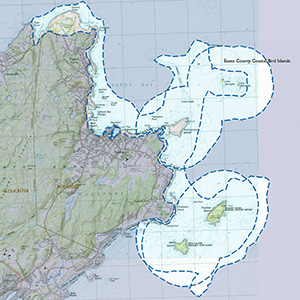Important Bird Area Sites in Massachusetts
Important Bird Area: Rockport Headlands and Inshore Waters
Site Summary
Nominated By
Chris Leahy
Size
700 acres
Towns and Counties
Gloucester, Lanesville, Rockport; Essex
Ownership
Department of Conservation and Recreation, municipal, private, Essex County Greenbelt Association, The Trustees of Reservation
Major Habitats
oak-conifer transition forest, early successional shrubland, emergent freshwater wetland, palustrine woodland swamp, shrub-scrub wetland, coastal rocky shore, marine/tidal, lake/pond
Land Use
nature conservation, hunting/ fishing, recreation, fisheries, water supply, residential, undeveloped
Serious Threats
non-native invasive plants, ecological succession, predators, residential development
IBA Criteria
- Category 4: Sites containing assemblages of species characteristic of a representative, rare, threatened, or unique habitat within the state or region.
Site Description
This IBA contains the main granite headlands of the Cape Ann peninsula from Folly Point, Gloucester, eastward and southward to Land's End and seaward to the 9 (or 18) Fathom contour. It also includes the uplands of DCR, TTOR and private holdings at Halibut Point; ECGA holdings at Folly Point; and wooded swamp and emergent freshwater wetlands west of Emerson Point. Best known for its seaward, jutting vantage points from which to watch migratory and wintering seabirds, this site also contains coastal coppices that attract numbers of migratory songbirds, raptors, and a few shrub/scrub breeding birds of interest. An aggregation of wetland systems near Emerson Point is of local conservation significance. The Atlantic Path, a traditional public access to the Rockport shore, runs from Folly Point to Pigeon Cove and is accessible by a number of well-marked, town-owned rights-of-way. These rights-of-way provide access to the intertidal zone for fishing, fowling, birdwatching, and navigating along the entire stretch of this IBA.
Current Conservation Status
Common Reed and Purple Loosestrife are encroaching on small wetlands, and non-native buckthorn, honeysuckle, barberry, and bittersweet have invaded successional shrublands. It should be noted that some priority bird species appear to thrive in both uplands and wetlands affected by these species. No management efforts to control invasive plants are underway. The relatively undisturbed habitats within this site represent a coastal fringe backed by dense residential development. This inevitably brings with it problems associated with habitat fragmentation; cowbirds and nest-robbing species are very common as are free-ranging house pets and feral cats. Inshore fishing, especially lobstering, is a major local industry, which might conceivably affect food sources for coastal birds though no such effect is detectable at present. Recreational boating, fishing, and scuba diving are on the increase with 70 or more nonsailing sporting craft routinely visible from Halibut Point in summer. No disturbance of birdlife is apparent.
Ornithological Significance
Common Loons use these waters from late fall through spring. In 2001, a pair of Least Bitterns reared two young in a Common Reed bed at the southern end of this site. While most other species do not meet the thresholds in this category, it is worth noting that the following species are recorded in small numbers annually at Eastern Point as migrants: Leach's Storm-Petrel, Sharp-shinned Hawk, Northern Harrier, Peregrine Falcon, Common Tern, Roseate Tern, Least Tern, Northern Parula, Blackpoll Warbler, and Mourning Warbler. While numerical thresholds may not be met, the following species occur along the shore annually: Snowy Egret, Black-crowned Night-Heron, American Black Duck, Whimbrel, Ruddy Turnstone, Sanderling, Short-billed Dowitcher, American Woodcock, Chimney Swift (breeds), Eastern Wood-Pewee, Least Flycatcher, Eastern Phoebe (breeds), Eastern Kingbird (breeds), Cliff Swallow, Gray Catbird (common breeder), Wood Thrush, Veery, Swainson's Thrush, Brown Thrasher (breeds), Blue-winged Warbler, Chestnut-sided Warbler, Black-throated Blue Warbler, Black-throated Green Warbler, Blackburnian Warbler, Prairie Warbler, Black-and-white Warbler, American Redstart, Canada Warbler, Indigo Bunting, Eastern Towhee (breeds), Field Sparrow, White-throated Sparrow, Rose-breasted Grosbeak, Bobolink, Scarlet Tanager, and Baltimore Oriole (breeds). Nearshore waters along this coastline from late fall to early spring support significant numbers of migratory and wintering gannets and alcids. Concentrations of loons, grebes, cormorants, and sea ducks typically exceed 500 birds from late fall to early spring. This shore currently supports a large wintering population of Harlequin Ducks. Purple Sandpipers Category 3f: More than 90 species of migratory passerines are recorded each year at Halibut Point State Park, with annual totals for all species of perching birds exceeding 100 species. Rocky shore is a globally scarce habitat type; in Massachusetts it occurs almost exclusively from Cape Ann south to Boston Harbor. The dominant habitat type at Halibut Point is coastal shrub-scrub thickets that support Gray Catbirds, Brown Thrashers, and Eastern Towhees. Coastal points throughout this site constitute one of the most the popular birdwatching routes from late fall through spring. Watch points such as Halibut Point, Andrews Point, and the intervening coves have been among the best-studied areas in Massachusetts for winter waterbirds.
Other Flora or Fauna of Significance
Sea Lungwort, Needham's Skimmer dragonfly.
Data Sources
None listed.




